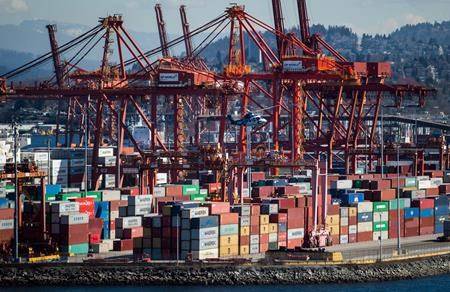The Canadian economy weakened in November as the wholesale trade and manufacturing sectors pulled back.
Statistics Canada said Thursday real gross domestic product fell 0.1 per cent in November following an increase of 0.3 per cent in October.
The report was in line with estimates that the contraction would be 0.1 per cent for the month, according to Thomson Reuters Eikon.
Benjamin Reitzes, Canadian rates and macro strategist at BMO Capital Markets, said the report changes little for the Bank of Canada, but reinforces that they’ll be extremely patient with policy.
“The Canadian economy had a tough stretch through the latter stages of 2018, and the oil production cuts will make the early 2019 data look soft as well,” Reitzes wrote in a report.
“However, this weakness is fully expected, with fourth quarter and first quarter growth forecasted to average about one per cent.”
The Bank of Canada kept its key interest rate target on hold at its last rate announcement. In making its decision, the central bank noted that the drop in oil prices at the end of last year will weigh on the economy, but predicted that the effects of the slump will dissipate and allow growth to resume.
READ MORE: B.C. home sales to slide 23% this year, rise next year: real estate group
Fotios Raptis, senior economist at TD Bank, said further weakness in the oil sector is expected to continue to weigh on overall growth as Alberta’s mandatory production cuts took effect in January.
“The temporary slump in the oil sector, combined with elevated global economic uncertainty warrants patience on behalf of the Bank of Canada,” Raptis wrote in a report.
The overall contraction in the economy came despite gains in 13 of the 20 industrial sectors tracked.
The wholesale trade sector fell 1.1 per cent in November as machinery, equipment and supplies wholesaling pulled back 2.1 per cent.
The manufacturing sector also contracted 0.5 per cent for the month, the third decline in four months.
The mining, quarrying and oil and gas extraction sector fell 0.1 per cent as mining excluding oil and gas extraction and supporting activities were more than offset by a drop in oil and gas extraction.
Mining excluding oil and gas extraction grew 2.3 per cent, while oil and gas extraction fell 1.6 per cent.
Conventional oil and gas extraction fell 2.2 per cent, while non-conventional oil extraction dropped 0.9 per cent.
The Canadian Press



